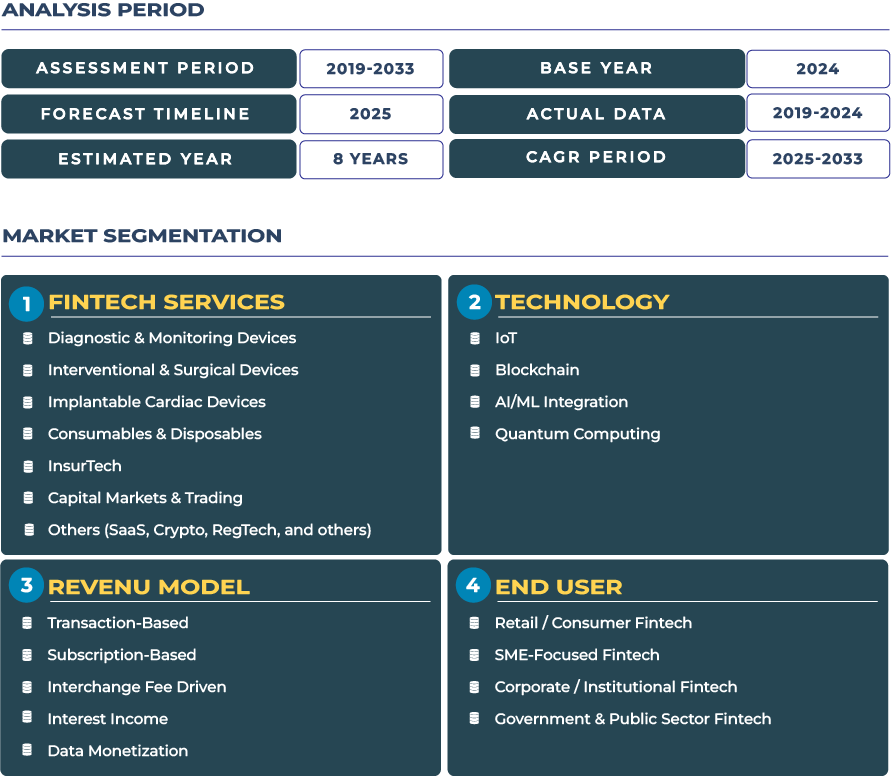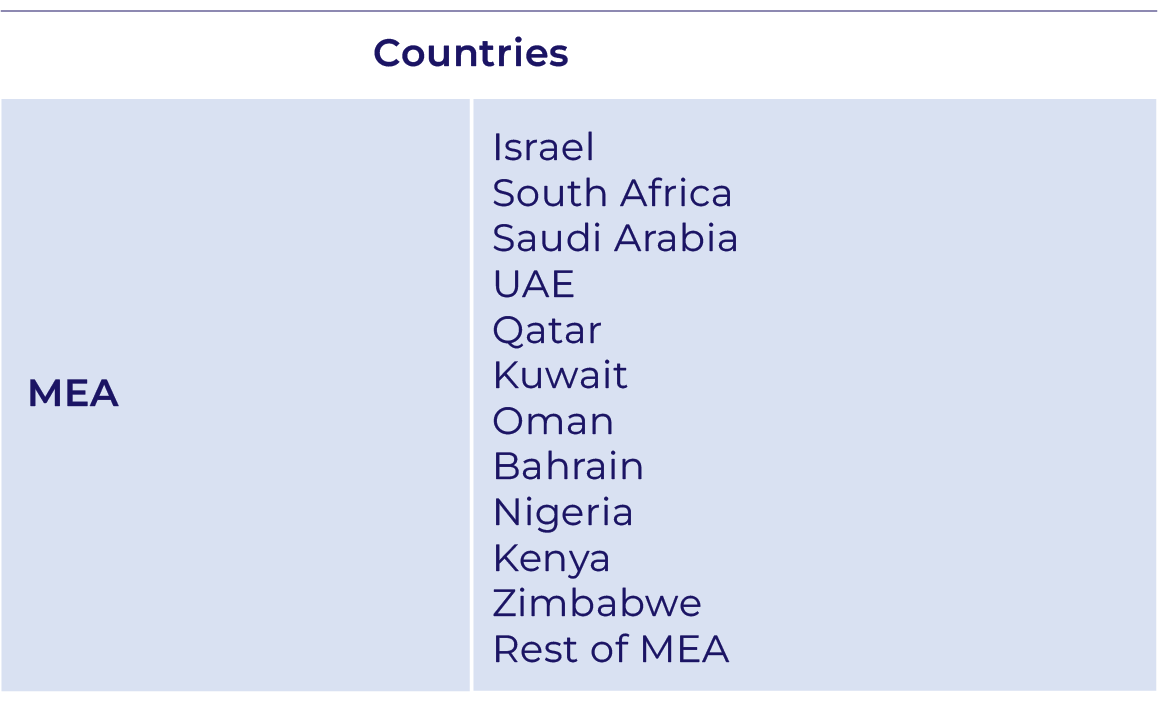Report Format:
![]()
![]() |
Pages: 160+
|
Pages: 160+
MEA Fintech Market Outlook: Bridging Financial Inclusion Through Mobile Money and Digital Rails
Introduction: Continental Fintech for Inclusion and Infrastructure Gaps
The Middle East and Africa (MEA) is emerging as one of the most dynamic fintech regions globally, where innovation bridges financial inclusion gaps and develops scalable digital infrastructure in economies with weak legacy systems. A large share of the population remains unbanked, yet mobile adoption is soaring, creating an opportunity for fintech players to leapfrog traditional banking barriers.
The MEA fintech market is expected to expand from USD 26.2 billion in 2025 to USD 81.3 billion by 2033, growing at a CAGR of 15.2% during 2025–2033. This growth is underpinned by mobile wallet adoption, infrastructure-light payments, and cross-border remittance corridors connecting the continent’s diaspora communities. Countries such as Nigeria, Kenya, Saudi Arabia, and the UAE are leading with innovation hubs that combine regulatory support and entrepreneurial density. Meanwhile, North and Sub-Saharan Africa are witnessing the rise of mobile-first fintech models enabling inclusive access to financial services.
Resilient Drivers and Structural Constraints Defining MEA Fintech Expansion
The MEA fintech industry is powered by favorable demographics, including a young and tech-savvy population. With over 60% of the region people under the age of 30, digital finance adoption has grown rapidly. Mobile money platforms such as M-Pesa have become cornerstones of financial inclusion in East Africa, while telcos in West Africa are expanding agent networks that reach remote communities. Rising demand for affordable credit and micro-insurance further accelerates fintech adoption in both rural and urban segments.
However, the market is constrained by persistent challenges. Political instability in parts of Sub-Saharan Africa, coupled with currency risks in volatile economies, hampers investor confidence. Regulatory fragmentation across markets also creates complexity for fintech firms seeking to scale regionally. Despite harmonization efforts in the Gulf Cooperation Council (GCC), differences in licensing and compliance remain a barrier to seamless cross-border expansion. These dynamics illustrate both the promise and the structural hurdles in scaling fintech solutions across MEA.
Digital Transformation Trends and Emerging Opportunities in MEA Fintech
Mobile money remains the most transformative trend in MEA, with transaction values growing year-on-year. In countries such as Kenya and Ghana, mobile wallets account for a significant share of GDP transactions. In North Africa, fintechs are rapidly integrating QR-code payments into small merchants’ ecosystems, allowing informal sector businesses to access digital financial rails. Diaspora remittances—worth hundreds of billions annually—are increasingly intermediated by fintech firms offering faster, lower-cost transfers compared to traditional banking channels.
Opportunities are expanding in digital ID-based onboarding, enabling instant Know Your Customer (KYC) compliance, particularly in countries where national ID programs are strong. Merchant payment solutions tailored for informal markets—where over 80% of Africa’s workforce is employed—represent another untapped growth area. By digitizing informal sector transactions, fintech companies can unlock credit histories and provide access to loans and insurance. Together, these opportunities position fintech as a central driver of economic modernization in MEA.
Government and Regulatory Frameworks Driving a Balanced Fintech Ecosystem
Governments in MEA are increasingly recognizing fintech as a strategic enabler of economic diversification and inclusion. In the Gulf, initiatives such as Saudi Central Bank (SAMA)’s fintech sandbox and the Central Bank of the UAE digital payment licenses have accelerated innovation. Similarly, in Africa, regulators like the Central Bank of Kenya have pioneered mobile money oversight, setting precedents for other countries.
While regulatory innovation zones encourage experimentation, challenges remain in harmonizing rules across fragmented markets. Efforts by pan-African organizations to establish digital finance interoperability are expected to reduce friction in regional remittance and payment flows. This balance between fostering innovation and ensuring financial stability is shaping MEA into a more mature fintech ecosystem.
Key Economic and Structural Factors Shaping MEA Fintech Performance
Fintech growth in MEA is closely tied to macroeconomic and structural factors. Mobile money transaction values continue to grow, exceeding trillions in cumulative flows across Sub-Saharan Africa by 2024. Diaspora remittance corridors, such as those linking the Gulf with North Africa and South Asia, generate sustained demand for efficient fintech solutions. Additionally, inflation and currency volatility drive both risks and opportunities, as consumers increasingly turn to digital platforms for stable remittance and credit access.
Urbanization trends also influence fintech uptake, with metropolitan hubs such as Lagos, Nairobi, Riyadh, and Dubai becoming key fintech development centers. These cities combine access to venture capital, regulatory support, and concentrated consumer demand, reinforcing their role as anchor points in the MEA fintech ecosystem.
Regional Country-Level Insights
- Saudi Arabia: A key fintech hub in the Gulf, driven by Vision 2030 reforms, strong banking sector support, and SAMA’s regulatory sandbox initiatives.
- UAE: A leader in fintech adoption, boosted by Dubai and Abu Dhabi’s global financial centers and Central Bank-led licensing frameworks.
- Qatar: Fintech growth aligned with its National Vision 2030, with emphasis on payments modernization and blockchain-enabled solutions.
- Kuwait: Limited fintech penetration but growing regulatory support for payments and digital banking expansion.
- Oman: Increasing digital payment adoption, supported by government-backed programs to encourage cashless transactions.
- Bahrain: A pioneer in open banking regulations, positioning itself as a fintech testing ground in the Gulf region.
- Israel: A global leader in cybersecurity and blockchain fintech, benefiting from a mature innovation ecosystem.
- South Africa: The most advanced fintech market in Africa, with diversified activity across payments, lending, and digital wealth management.
- Nigeria: Africa’s largest fintech hub, driven by mobile-first banking models and rapid venture capital investment.
- Kenya: A pioneer in mobile money through M-Pesa, now evolving into insurtech and credit-focused fintech solutions.
- Zimbabwe: Strong mobile money reliance due to currency instability, positioning fintech as a lifeline for daily transactions.
Competitive Landscape: Market Entry, Spin-Offs, and Cross-Sector Partnerships
The MEA fintech competitive landscape is dynamic, blending telcos, startups, and global players. In July 2025, MTN Group announced the spin-off of MTN Uganda fintech arm into a standalone company, a move designed to unlock shareholder value and accelerate partnerships. Similar strategies are being pursued by telcos across Africa, where fintech revenues are becoming increasingly central to their long-term growth.
Local innovators such as Paystack in Nigeria and global entrants like Visa and Mastercard are expanding partnerships to enhance merchant acceptance and cross-border payments. Wealthtech and insurtech startups in Israel and South Africa are gaining momentum, focusing on advanced use cases such as digital wealth management and AI-driven risk assessment. The ecosystem is defined by rapid experimentation, cross-sector partnerships, and scale-driven corporate strategies.
Conclusion: MEA as the World’s Testing Ground for Inclusive Fintech Innovation
The MEA fintech market embodies the convergence of financial inclusion, demographic demand, and regulatory innovation. By bridging gaps in underserved populations and offering scalable, infrastructure-light solutions, fintech has become a structural driver of modernization across the region. Mobile money, remittance platforms, and digital wealth services are transforming consumer access to finance, while cross-border integration opportunities expand the region’s role in the global financial system.
Yet, success depends on navigating risks—political instability, currency volatility, and fragmented regulatory landscapes continue to pose challenges. The path forward lies in fostering stronger partnerships between telcos, banks, governments, and fintech startups to ensure sustainable ecosystem growth. With its scale, diversity, and unmet demand, MEA is not only a fast-growing fintech market but also a global laboratory for how technology can close access gaps and deliver inclusive economic value.








